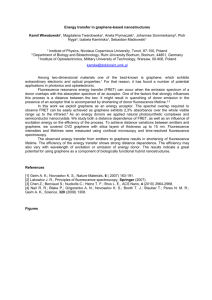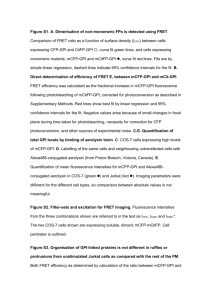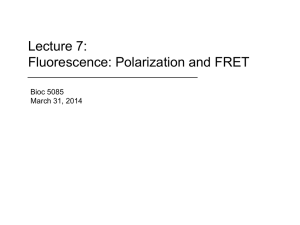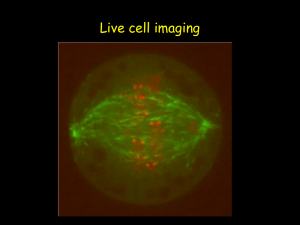Fluorescence Resonance Energy Transfer (FRET)
advertisement
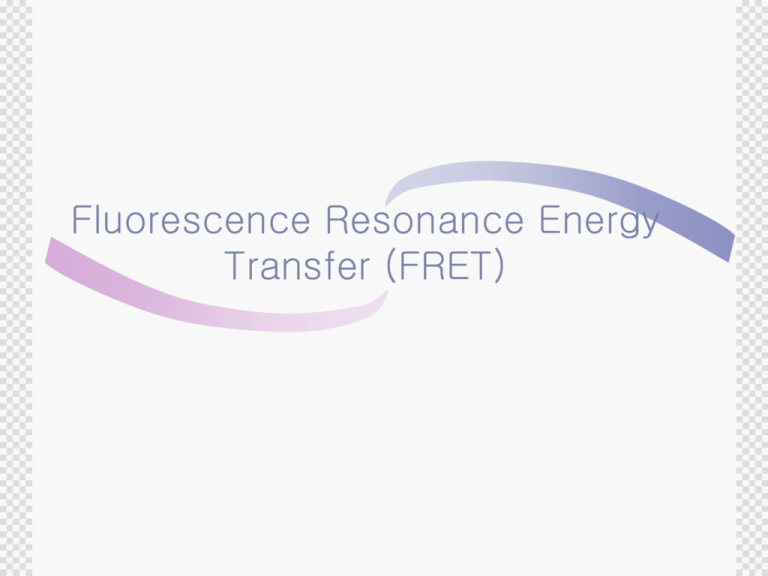
Fluorescence Resonance Energy Transfer (FRET) FRET Resonance Energy Transfer Resonance energy transfer can occur when the donor and acceptor molecules are less than 100 A of one another Energy transfer is non-radiative which means the donor is not emitting a photon which is absorbed by the acceptor Fluorescence RET (FRET) can be used to spectrally shift the fluorescence emission of a molecular combination. FRET The mechanism of FRET involves a donor fluorophore in an excited electronic state, which may transfer its excitation energy to a nearby acceptor chromophore non-radiative fashion through long-range dipoledipole interactions FRET The absorption spectrum of the acceptor must overlap fluorescence emission spectrum of the donor Fluorescnece Intensity J(λ) Donor fluorescnece Acceptor absorption Wavelength FRET Energy Donor excitation state Emission Acceptor excitation state 학교 제도 : 교육 제도 중 학교에 관한 제도 사회적으로 가장 먼저 공인된 제도, 형식적 교육 제도 1) 서구 사회의 학교 제도 - schola : 한가, 여가를 뜻함, 오늘날의 학교 school -고대 그리스 사회에서 지배계급의 지위와 신분을 유 지하기 위해 소수의 귀족계급을 위해 조직되어 교육 실시 -중세 유럽사회의 학교는 소수의 성직자나 지도자 양 성 을 위한 교회부속의 사원 학교가 대부분 FRET 488nm light excitation excitation FITC FITC TRITC TRITC 520nm light 630nm light FRET Distance dependent interaction between the electronic excited states of two molecules *not sensitive to the surrounding solvent shell of a fluorophore *Donor-Acceptor의 Energy transfer는 거리에 의해 효율이 결정 (~10nm) Spectral properties of involved chromophore FRET Calculation Efficiency of Energy Transfer = E = kT/(kT + kf + k’) kT = rate of transfer of excitation energy kf = rate of fluorescence k’ = sum of the rates of all other deexcitation processes E = R60/ R60+ R6 FRET Förster Equation Ro= Forster radius = Distance at which energy transfer is 50% efficient = 9.78 x 103(n-4*fd*k2*J)1/6 Å fd- fluorescence quantum yield of the donor in the absence of acceptor n- the refractive index of the solution k2- the dipole angular orientation of each molecule j- the spectral overlap integral of the donor and acceptor Typical values of R0 Donor Acceptor Ro(Ǻ) Fluorescein 55 IAEDANS Tetramethlrhoda mine Fluorescein EDANS Dabcyl 33 Fluorescein Fluoresscein 44 BODIPY FL BODIPY FL 57 Fluorescein Qsy7&Qsy9 dyes 61 46 FRET Critical Distance for Common RET Donor-Acceptor Pairs FRET Förster Equation Förster Equation D 2 ~ F ~ d~ k WDA 8.8 1017 r4 6 A ~D4 n R FRET Schematic diagram of FRET phenomena FRET SUMMARY Emission of the donor must overlap absorbance of the acceptor Detect proximity of two fluorophores upon binding Energy transfer detected at 10-80Ǻ FRET FRET Biological application using FRET (ex: cameleon) Inter-molecular FRET Intra-molecular FRET FRET Biological application using FRET Outline 1. What is fluorescence?? 2. Fluorescent molecules 3. Equipment for single-molecule fluorescence experiments 4. Some applications & examples fluorescence from molecules physical fundaments photon molecule in ground state photon molecule in excited state light can induce transitions between electronic states in a molecule intersystem crossing S1 internal conversion fluorescence absorption fluorescence the Jablonski diagram T0 -hν internal conversion +hν S0 radiationless transition transition involving emission/absorption of photon fluorescence properties that can be measured • spectra (environmental effects) • fluorescence life times • polarization (orientation and dynamics) • excitation transfer (distances -> dynamics) • location of fluorescence fluorescence requirements for a good fluorophore • good spectral properties • strong absorber of light (large extinction coefficient) • high fluorescence quantum yield • low quantum yield for loss processes (triplets) • low quantum yield of photodestruction • small molecule / easily attachable to biomolecule to be studied 1.7 Fluorescence quantum yield 1 fluo kr knr S1 kr S0 knr kr fluo 1 kr knr fluorescence chromophores: intrinsic or synthetic?? • common intrinsic fluorophores like tryptophan, NAD(P)H are not good enough R NH • chlorophylls & flavins work O H3C N H3C N NH N O R in most cases extrinsic fluorophores have to be added: • genetically encoded (green fluorescence protein) (H3C)2N N+(CH3)2 O • chemical attachment of synthetic dyes OCH3 O R fluorescence 580 a typical synthetic chromophore: tetramethylrhodamine Absorption / Emission (a.u.) Absorption Emission 400 • • • • 450 500 550 600 wavelength (nm) 650 700 extinction coefficient: ~100,000 Molar-1 cm-1 fluorescence quantum yield: ~50% triplet quantum yield <1% available in reactive forms (to attach to amines, thiols) and attached to many proteins and other compounds (lipids, ligands to proteins) the fluorescence of a single TMR can be measured easily extinction coefficient (): ~100 000 M-1 cm-1 absorption cross section (s) -16 cm2 s = · 2303 / N : ~4·10 0 s = area of an opaque object with the same that blocks the lightpower: as good as the molecule excitation ~100 W/cm2 excitation photon flux = power / photon energy: dI/I = (s·C·N Av/1000)·dL photon energy = h·c/l ~2.5 · 1020 photons·s -1·cm-2 #excitations·molecule-1·s-1 #exc = flux·s dI/I = ·2.303·dL ~105 photons·s -1·cm-2 #emitted photons·molecule-1·s-1 #em = #exc·QY ~105 photons·s -1·cm-2 single-molecule fluorescence microscopy • excitation source: laser Lasers cw (ion), pulsed (Nd-YAG, Ti-sapphire, diodes • optical system with high collection efficiency: high NA objective • optics to separate fluorescence from excitation light: filters / dichroic mirrors monochromators, spectrographs; filters: colored glass, notch holographic, multidielectric • detector: - CCD camera, PMT - eyes; PMT, APD, CCD PhotoMultiplier Tube, Avalanche PhotoDiode, Charge Coupling Device (signal is usually weak) + electronics rotation of F1-ATPase Adachi, K., R. Yasuda, H. Noji, H. Itoh, Y. Harada, M. Yoshida, and K. Kinosita, Jr. 2000. Proc. Natl. Acad. Sci. U.S.A. 97:7243-7247 folding / unfolding of RNA (Tetrahymena ribozymes) X. Zhuang, L. Bartley, H. Babcock, R. Russell, T. Ha, D. Herschlag, and S. Chu Science 2000 June 16; 288: 2048-2051. FLUORESCENCE MEASUREMENTS • Information given by each property of fluorescence photons: - spectrum - delay after excitation (lifetime) - polarization Spectra Sample Laser lexc Spectrograph Fluo. intensity Detector lfluo lexc lfluo Excitation spectrum Fluorescence spectrum Solvent effects Energy Non-polar solvent Polar solvent S1 S1 S1 S0 Static molecular dipole moment S0 Fluorescence Lifetime Sample number Pulsed laser e t / fluo Filter delay, t Detector Laser pulses photons delay time Polarization Rigid polarized Fluid depolarized Polarization memory during the fluorescence lifetime : fluo. anisotropy Fluorescence Resonance Energy Transfer (FRET) Dipole-dipole interaction (near-field) VAD 1 40 R ˆ ˆ 1 3RR D 3 A Donor Acceptor Transfer Efficiency • Fraction of excitations transferred to acceptor E k DA k DA k fD 1 R 1 R0 6 • R0 = Förster radius, maximum 10 nm for large overlap Förster Resonance Energy Transfer R>10 nm R<10 nm FRET studies of interaction and dynamics (molecular ruler) Association of two biomolecules Dynamics of a biomolecule Other specific labeling and imaging • Possibility to specifically label certain biomolecules, sequences, etc. with fluorophores • Staining and imaging with various colors • Detection of minute amounts (DNA assays) • Fluorescence lifetime imaging (FLIM) • Fluorescence recovery after photobleaching multicolor 2-photon microscopy specific labeling with various colors Fluorescence Correlation Spectroscopy I(t+ I(t) g (2) I (t ) I (t ) t g(2) log Keeps track of the fluctuations of the fluorescence intensity. Single molecule spectroscopy • • • • • Single molecule tracking dynamics of single enzyme sp-FRET orientation fluctuations lifetime measurement
